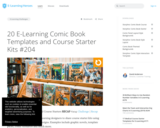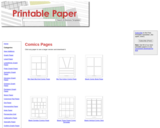
"...course starter kits using the popular comic book style designs. Examples include graphic novels, template packs, comic scenarios and much more. "
- Subject:
- English Language Arts
- Material Type:
- Activity/Lab
- Date Added:
- 05/06/2020

"...course starter kits using the popular comic book style designs. Examples include graphic novels, template packs, comic scenarios and much more. "

The culminating art and writing projects for each of the Comox Valley Schools (SD71, B.C.) middle-grade Core French units (also searchable on the Resource Bank). All would be adaptable for younger and older students. These could also been done as separate assignments, but are best scaffolded by the activities in each unit!
/
Ces projets d'art et de rédaction sont destinés aux élèves de Core French, mais pourraient également être utiles dans des cours d'Immersion!
UNIT THEMES (those with art/writing projects, searchable on the Resource Bank):
-Greetings & letters (saluer & alphabet)
-Numbers & calendar (chiffres & calendrier)
-Who are you? (Qui es-tu?)
-Body parts & monsters (le corps & les monstres)
-Clothing (les vêtements)
-Sports (les sports)
-Hobbies (les passe-temps)
-Animals (les animaux)
-High-frequency words (Les mots de haute fréquence)
-Food (la nourriture) - unit 2/2e unité

Card and board game kits for many of the Comox Valley Schools (SD71, B.C.) middle-grade Core French units (also searchable on the Resource Bank). All would be adaptable for younger and older students. There are also flash card sets with the units themselves.
/
Ces jeux sont destinés aux élèves de Core French, mais seraient également très utiles pour susciter la participation à l'oral dans les cours d'Immersion! Des cartes flash sont aussi disponibles avec chaque unité (recherchables dans la Banque de Ressource).
UNIT THEMES (those with flash cards and games, searchable on the Resource Bank):
-Greetings & letters (saluer & alphabet)
-Numbers & calendar (chiffres & calendrier)
-Who are you? (Qui es-tu?)
-Body parts & monsters (le corps & les monstres)
-Clothing (les vêtements)
-Sports (les sports)
-Hobbies (les passe-temps)
-Animals (les animaux)
-High-frequency words (Les mots de haute fréquence)
-Food (la nourriture) - unit 2/2e unité

Create comics awesome in an infinite number of ways!

Templates for a variety of comics.

This thematic unit from Comox Valley Schools (SD71) in B.C. is aimed at Grade 7 Core French students, but is suitable and/or adaptable for both younger and older grades. It is focused on oral practice and participation and would also be useful in French Immersion classes!
THIS UNIT'S THEME: High-Frequency Words (Mots de haute fréquence)
In addition to tips for incorporating French into daily routines, the unit includes:
-Vocabulary
-Pronunciation videos
-Kahoot/flash card games
-Word games
-Games and activities for oral practice
-An art & writing activity
The same page details other units and a Cultural Study: La Francophonie.

This course is good for anyone over 13 years old!
"The How to Make a Comic Book online course is a project-centered course designed for all-age learners (ages 13+) who are brand new to the comic-making process. The course features a bevy of resources for new comic-makers including tutorials, models, comic industry guest speakers, and exercises.
The course walks participants through the full process of comic creation, starting at brainstorming and covering scripting, thumbnailing, penciling, lettering by hand, inking, and final assembly. The course culminates in the creation of a final 4-page comic."
Enroll in the course and the materials will be emailed to you.
The course is free, self-paced and should take 8-20 hours.

Students create a theme park for the novel “Where the Red Fern Grows" using Makerspace. OR Students create a comic book that describes all of the sequential plot elements of the story. OR Students create a test using Quizlet or Kahoot that explores all the story elements.

Courtesy of Comox Valley Schools (SD71) in B.C., an archived site with a series of excellent kits for middle-grade Core French units that carefully structure and encourage oral communication. Some elements would be adaptable for younger or older grades, and/or useful in immersion!
THIS KIT'S THEME: Ma vie... c'est moi! (My Life... It's Me!)
«This Mon passport theme , “Ma vie” / “My life” includes basic greetings,
basic questions, emotions, colours and numbers.
« After asking and answering questions together as a class, students can then move
between stations. These stations are not sequential, but rather provide practice
communicating about each theme in different ways. The station titles ... are:
a. Comment ça va?
b. Bandes dessinées / Comics
c. Emojis
d. C’est moi! / It’s me!
e. Chanter/Sing
f. Une dictée / Spelling list or Spelling bee
g. Calculer / Calculate
h. Colorier / Colour
i. Sac magique / Magic bag »

In this lesson by Creative Educator students explore and analyze familiar heroes and villains, develop their own superhero, and introduce this new hero to the world through an ID card and comic.
For students in grades 3-6.

This is an activity about sunlight as an energy source. Learners will create a plant box and observe that a plant will grow toward the Sun, its primary source of energy. This hands-on activity is an additional lesson as part of the book, The Day Joshua Jumped Too Much.

These tools can be used in SK in Social Studies and Language classes from grades 6 to 9.
-Aushwitz
-Hana's Suitcase
-Studying the Holocaust at home
-17 Letters
-Draw Me: Jews in the Netherlands during the Holocaust
-Us vs. Them - Creating the "Other"
-Refugee
-Genocide
-Maps
-Analysis Sheets
-History of Holocaust
-History of Antisemitism
***+ virtual and travelling exhibitions

Learners will read or listen to a story about two sisters, Marisol and Sofia, as they explore the Sun's role in the water cycle. Additionally, numerous extension resources are included in the accompanying educator guide, such as suggestions for no-cost language arts activities, links to further science activities, a book walk cue chart to guide classroom discussion before, during, and after the story, a graphic organizer, and alignments to the National Science Education Standards (NSES) and the Next Generation Science Standards (NGSS).